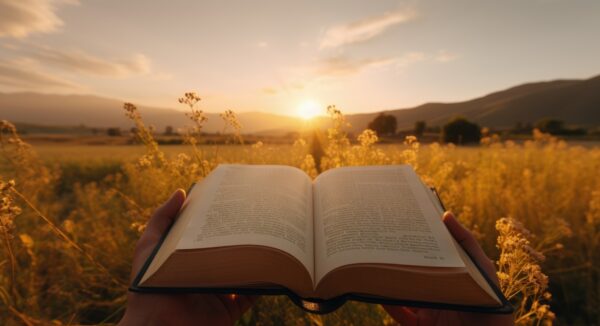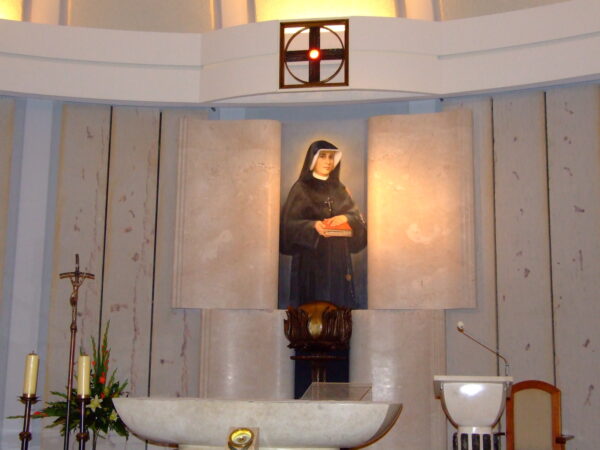Have you ever been completely surprised by the Lord using one of your passions to teach you how to grow in intimacy with him?
For the last few years, I have practiced the “word of the year” as I was taught by the wonderful women of the Abiding Together Podcast. This year my word was “intimacy.” I was unsure how this would play out in the months to come, but when I made the decision to pursue a long-time dream of learning how to dance, I began to realize that he was inviting me into even greater intimacy through the joy and beauty of ballroom dancing.
I started taking lessons in the spring, during Lent. At the same time, I had committed Saturday Eucharistic adoration at a beautiful, local 24-hour chapel whenever I could manage it. These two things worked together in a way I never could have anticipated. During those moments in the chapel, I would be praying about something going on in my personal life, usually related to the challenges of being single and desiring marriage, and suddenly my memory would jump back to something I had been taught in my dance lesson, and the connection between dance and the spiritual life would blow me away for the rest of my holy hour.
Want more Radiant? Sign up for our weekly newsletter!
Ballroom dancing encompasses a number of styles, but they are normally split into two main categories: smooth, which includes waltz, foxtrot, tango and Viennese waltz; and rhythm, which includes cha-cha, rumba, swing, bolero and mambo. Other styles of social dancing may also be included.
Lead and follow
In dance, the two partners are referred to as the “lead” and the “follow,” which could also be described as the “man’s role” and the “woman’s role,” respectively. The lead has a very generative role within every style, leading his partner through the dance by providing the framework. The follow, on the other hand, has a very receptive role. She responds to the framework by gracefully unfolding within this framework to create a moving masterpiece in which both body and soul are engaged.
There is a theological “mirror-image” at work here. The lead is very much an image of God’s creative action. God generates everything that exists, but he also creates human beings with a free will so that they can actively cooperate with his grace and unfold into a beautiful masterpiece: a fully alive human being — in other words, a saint. The follow, in its proper sense, is an image of the disciple. Our role in the relationship with God is to respond to the directives and promptings of the Lord in order to become the saints he created us to be.
What’s more, twice in the same week two different dance instructors taught me that whenever something goes awry in the dance, the lead is the one to set it right. That does not mean that the follow ignores what went wrong and does not try to improve; but in the moment, an honest mistake is best remedied by letting the man lead. Similarly, when we are doing our best to follow the Lord and freely choose what we think to be the good and then find we might have misjudged the situation, we need to allow the Lord to work with our mistakes in order to set all things right. We do not have to do all the work ourselves. He will take care of it if we surrender to him.
Connection
How do you know what to do when you are dancing? Connection is the answer. Of course, instruction is important, but a strong connection can even overcome lack of instruction when it is active and attentive. Connection can come in a variety of forms, but it can be described as the subtle and unspoken communication between the partners. For the follow, it is attentiveness to the promptings of the lead to move into and out of particular figures.
Connection can be kept through the hands, arms and back (for the follow) when the couple is dancing “in frame.” The points of connection are important because, when the connection is active, the partners can feel slight changes in the pressure or position of each other’s hands when they are about to change direction or begin a figure. Footwork can also be a means of connection. Sometimes a figure will send the partners away from each other so that they are not in-frame and not touching. The connection in these figures is kept active through the footwork and rhythm of the dance itself. If the partners keep the rhythm and pattern of the footwork, the connection is kept. A loose or disengaged connection deprives the partners of the ability to read and listen to one another.
When I first learned about connection as this subtle communication that lets the follow know what to do moment to moment, I was instantly reminded of what it is like living according to the promptings of the Holy Spirit. Prayer is the instructive piece — I learn to recognize the voice and movements of the Lord in my life and what he desires for me. The life of grace and the indwelling of the Holy Spirit then sustain me throughout the day so that, moment to moment, I am listening for and responding to the promptings of the Spirit and seeking God’s will. Those who have a strong and long-standing habit of prayer will tell you that, more often than not, you won’t hear words being spoken; rather, you have an inner sense of what God is inviting you to do, and then you either respond or you don’t.
Presence
Being aware of the active connection to one’s partner is essential. This means being attentive to what your partner is prompting you to do right now. Where I often find myself making mistakes when I dance is when I am trying to anticipate and be mentally prepared for what my partner is going to prompt me to do; instead, I should be actively aware of what he is prompting me to do in the moment.
When my instructor pointed this out to me, I took it in at face value. But a couple days later in adoration, the Lord led me right back to that conversation to show me how I was often falling into the same trap with him. Instead of living in the present moment and responding to the grace of the now, I was trying to figure out what God will do in my life next or what I ought to do in the future. This is so often the trap the devil sets for us, as I remember reading in a devotional: He keeps us preoccupied with the past or worried about the future because we can only receive the grace of God in the present moment. Instead of trying to anticipate God’s next move in my life, what would it look like to live in the present moment and respond to his grace moment by moment, like in a dance?
Tension
There is always a level of tension to be kept within dance since both partners must be involved. The man prompts the woman’s movement, but the woman and the man both must create space for one another and to act in order for the dance to continue. The man must lead the woman through the figure, and the woman must respond, but she must not respond too soon or too late. For the follow to truly know what the lead is inviting her into, she must wait and then respond at the opportune moment — not too soon, not too late. This is very challenging but possible when the follow focuses on connection and presence. Both partners must move with purpose but also freedom.
There is so much “both/and” when it comes to dance, just like there is with our Catholic faith. This is one of my favorite things about doctrine. When faced with two extremes, the response of God through his Church is not usually “either/or” or “neither/nor” alone; rather, it is a “both/and” response: both realities must be held in tension in order to find the appropriate balance that is in harmony with God’s law of love.
The dance of the spiritual life is so beautifully paralleled by the art of ballroom dancing. The Lord has invited me into greater intimacy with him through this new passion, and I am so excited to see where he leads me to follow him next.




